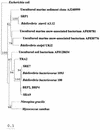Prey range characterization, ribotyping, and diversity of soil and rhizosphere Bdellovibrio spp. isolated on phytopathogenic bacteria
- PMID: 10831412
- PMCID: PMC110534
- DOI: 10.1128/AEM.66.6.2365-2371.2000
Prey range characterization, ribotyping, and diversity of soil and rhizosphere Bdellovibrio spp. isolated on phytopathogenic bacteria
Abstract
Thirty new Bdellovibrio strains were isolated from an agricultural soil and from the rhizosphere of plants grown in that soil. Using a combined molecular and culture-based approach, we found that the soil bdellovibrios included subpopulations of organisms that differed from rhizosphere bdellovibrios. Thirteen soil and seven common bean rhizosphere Bdellovibrio strains were isolated when Pseudomonas corrugata was used as prey; seven and two soil strains were isolated when Erwinia carotovora subsp. carotovora and Agrobacterium tumefaciens, respectively, were used as prey; and one tomato rhizosphere strain was isolated when A. tumefaciens was used as prey. In soil and in the rhizosphere, depending on the prey cells used, the concentrations of bdellovibrios were between 3 x 10(2) to 6 x 10(3) and 2.8 x 10(2) to 2.3 x 10(4) PFU g(-1). A prey range analysis of five soil and rhizosphere Bdellovibrio isolates performed with 22 substrate species, most of which were plant-pathogenic and plant growth-enhancing bacteria, revealed unique utilization patterns and differences between closely related prey cells. An approximately 830-bp fragment of the 16S rRNA genes of all of the Bdellovibrio strains used was obtained by PCR amplification by using a Bdellovibrio-specific primer combination. Soil and common bean rhizosphere strains produced two and one restriction patterns for this PCR product, respectively. The 16S rRNA genes of three soil isolates and three root-associated isolates were sequenced. One soil isolate belonged to the Bdellovibrio stolpii-Bdellovibrio starrii clade, while all of the other isolates clustered with Bdellovibrio bacteriovorus and formed two distantly related, heterogeneous groups.
Figures





References
-
- Baer M L, Ravel J, Chun J, Hill R T, Williams W N. A proposal for the reclassification of Bdellovibrio stolpii and Bdellovibrio starrii into a new genus, Bacteriovorax stolpii comb. nov. and Bacteriovorax starrii comb. nov., respectively. Int J Syst Evol Microbiol. 2000;50:219–224. - PubMed
-
- Carlson R W, Rheus B, Chen T B, Bhat U R, Noel K D. Lipopolysaccharide core structures in Rhizobium etli and mutants deficient in O antigen. J Biol Chem. 1995;270:11783–11788. - PubMed
-
- Curl E A, Truelove B. The rhizosphere. Berlin, Germany: Springer-Verlag; 1986.
Publication types
MeSH terms
Substances
Associated data
- Actions
- Actions
- Actions
- Actions
LinkOut - more resources
Full Text Sources
Molecular Biology Databases
Miscellaneous

